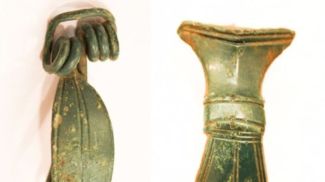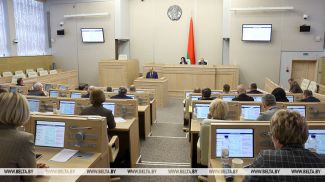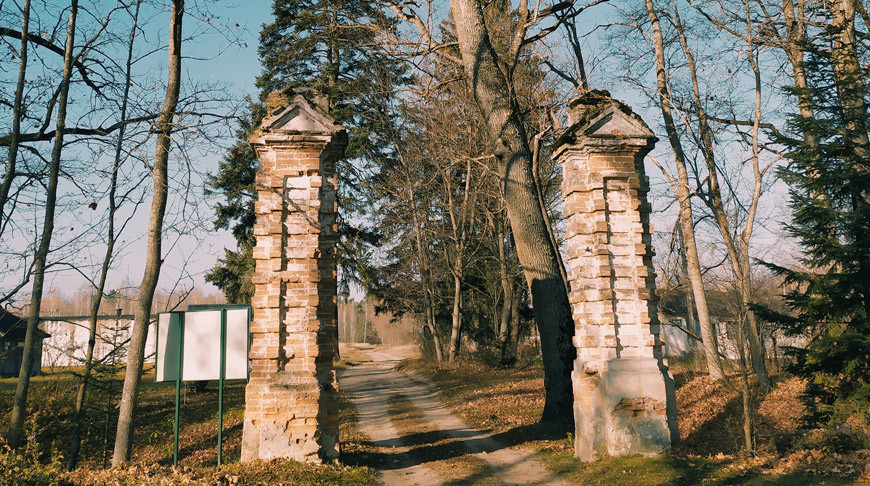
A city, a distant farmstead, a road or even a memory of the things gone by… Many sights in Belarus are associated with the names of our compatriots who had a hand in their creation. We offer you a trip to Polesie to see some of them.
Polesie ‘Versailles’
The oldest village of Duboye in Pinsk District is a keeper of many legends and is home to many sights. This special place, known since the 15th century, was owned by the Poloz, Sapieha, Oginski, Radziwill, and Kurzeniecki families. Duboye is also associated with the names of Hegumen of Brest Athanasius Filipovich and Catholic Saint Andrew Bobola. The last king of the Polish-Lithuanian Commonwealth, Stanisław August Poniatowski, and Swedish King Charles XII visited the local estate.
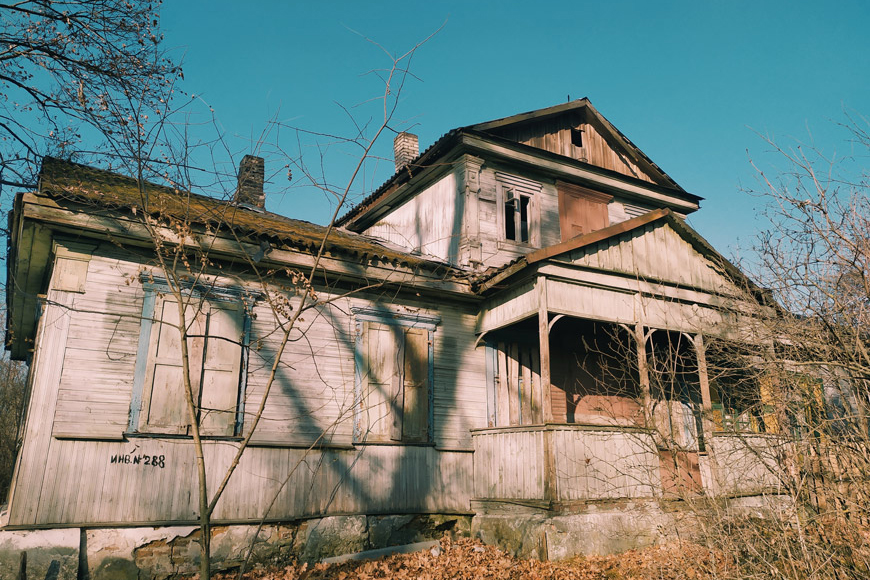
The estate had its heyday in the 18th century, when Duboye was owned by the Kurzenieckis. They had a palace built here, with all 16 rooms frescoed. Unfortunately, during the Great Patriotic War, it was completely destroyed.
French landscape designer André Le Nôtre, the head gardener at the Tuileries, oversaw the development of the "Pinsk Versailles", a park with an intricate system of water canals. Later, a cemetery of Russian and German soldiers who died during the First World War was built on its grounds.
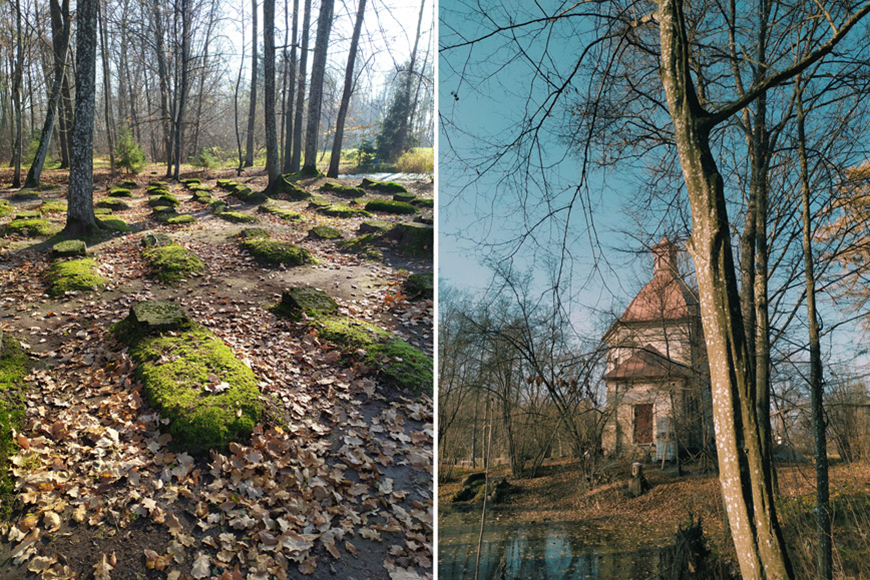
Next to the park you can see the Chapel of the Exaltation of the Cross. Its story is quite remarkable. For some time, it was home to an Orthodox monastery which was headed by Venerable Martyr Athanasius Filipovich. In the 17th century, the estate was transferred to the Pinsk Jesuits. They set up a summer residence, and next to the palace they built a chapel in the Baroque style, which later became the Church of the Holy Cross. After the expulsion of the Jesuits, the monastery was closed, and the church again became a chapel.
In addition to the chapel, the estate has preserved the entrance gate, outbuildings, fragments of the park with a huge five-century-old oak tree, overgrown canals and some of the bridges across them.
On the other side of the village stands the Church of the Nativity of the Virgin Mary built in the early 19th century. In front of it is a small wooden bell tower and a wooden mansion. The latter was once part of a church compound where a priest lived.
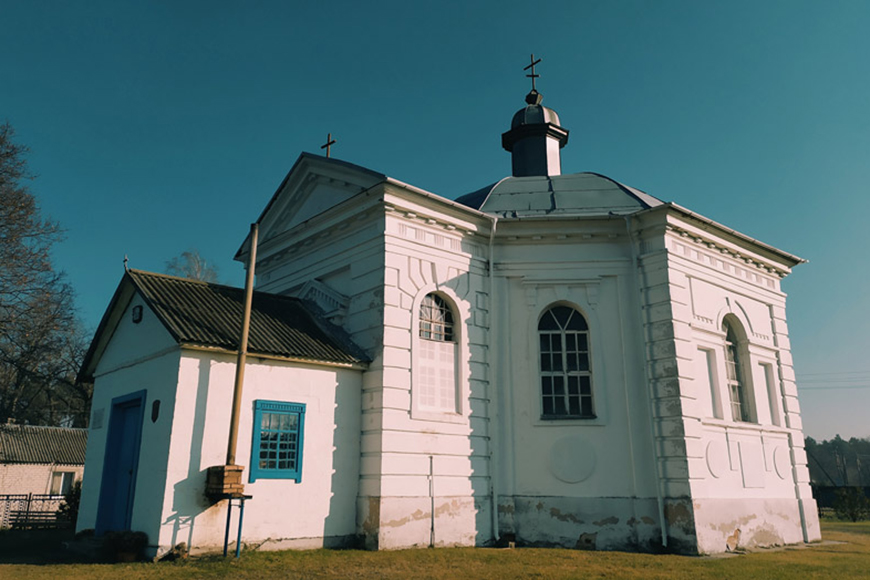
Trilinka
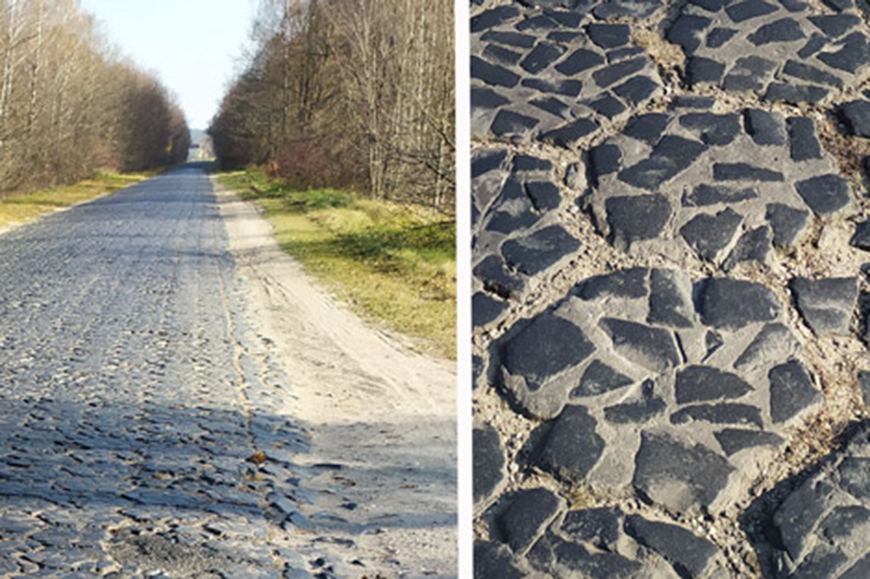
Napoleon Orda and Andrew Bobola
Having driven along the trilinka pavement and enjoying picturesque landscapes, you will find yourself in Ivanovo, the center of the same-name district.
It was first mentioned in chronicles in the 14th century as the village of Porkhovo. In the 15th century, the village was given to the Lutsk bishop Jan Łesowicz who renamed it in his honor. Thus, the village of Yanovo became the second residence of the Lutsk bishops.
A member of the Jesuit order, Andrew Bobola, was captured and tortured to death in Yanovo during the Russian-Polish war in the mid 17th century. This Catholic saint and martyr is called the Apostle of Polesie or the Apostle of Pinsk.
Following the third partition of the Polish-Lithuanian Commonwealth, Yanovo was made part of the Russian Empire and renamed as Ivanovo.

Until the 1940s, the place was famous for “labori”. This was the name given to local men who raised money for the construction and restoration of Orthodox churches.
The Chapel of the Exaltation of the Cross and the Church of the Protection of the Blessed Virgin Mary were built in the center of the town.
The former one was built in the mid-19th century in the Empire style with the help of the rector Frantishek Pallulon. He was a friend of the Russian Emperor Nicholas I. To commemorate this friendship, the icon of St. Catherine, a gift from the Emperor, was kept in the side altar until the Great Patriotic War. Today the relics of Andrew Bobola are kept here, and there is a chapel in his honor. There is also a wooden cross carved by Napoleon Orda (he was baptized in this church). The figurine of Jesus Christ was made by Helena Skirunt, the artist's niece. The church was closed during Soviet times. It resumed service only at the end of the 20th century.
The Church of the Protection of the Blessed Virgin Mary in Ivanovo was built in the early 20th century in the retrospective Russian style. Its walls are decorated with icons of the 17th-19th centuries. It is said that during World War I, when the city was occupied by German troops, the church was turned into a hospital. Although only lightly wounded soldiers were brought here, no one survived. A stable was set up in the church, but the horses began to die, too. The Germans decided to return the church to the believers. In Soviet times the parishioners managed to keep the church open as well.
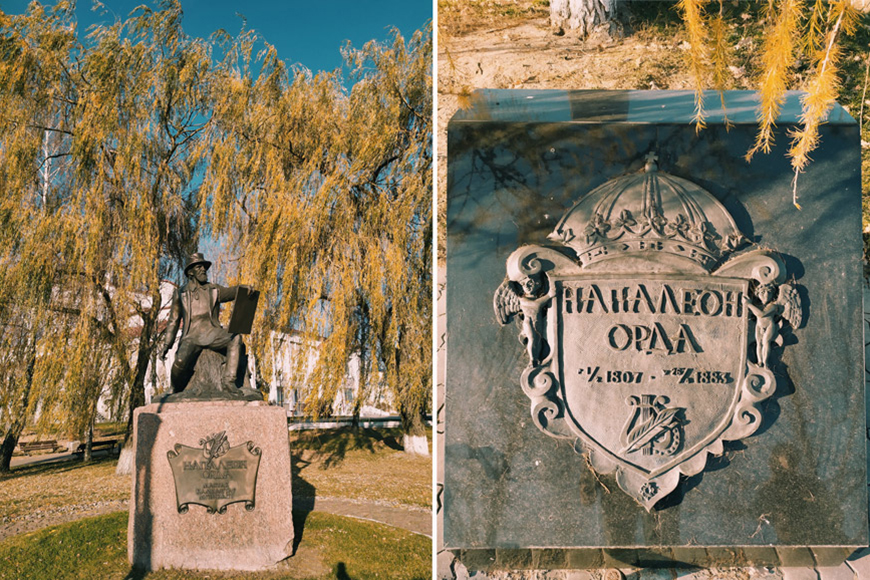
Ivanovo produced many great individuals who made their mark on culture and arts. There are memorial crosses and memorial signs in the places where Andrew Bobola was captured and executed. There is also a monument to Napoleon Orda in the city and a memorial sign at the place of the former Orda family crypt. The local history museum narrates the history of Ivanovo and displays the items and documents related to the life of the famous artist.
In Ivanovo, you can take a stroll along a trylinka-paved street.
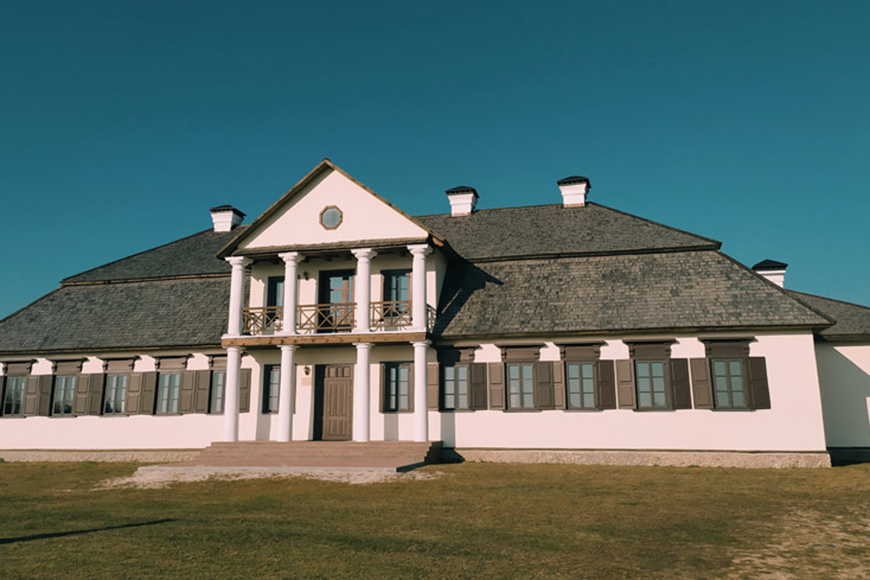
Birthplace of Napoleon Orda
Further our journey goes to the village of Vorotsevichi in Ivanovo District. The great Belarusian cultural figure, writer, musician, composer, painter, sculptor and teacher Napoleon Mateusz Tadeusz Orda was born and grew up here in the early 19th century.
He was acquainted with Liszt, Rossini, Verdi, Berlioz, Stendhal and Turgenev. Together with Chopin, they played music in the homes of such prominent families as the Platers and the Czartoryskis. He accompanied Adam Mickiewicz during his poetic improvisations. He also conducted the Italian Opera in Paris.
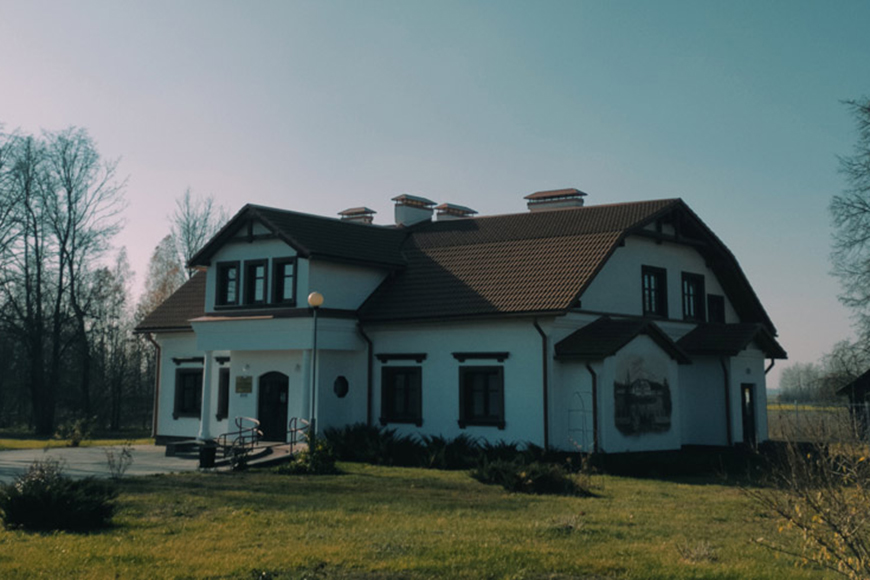
Text and photos by Ksenia Dmitrieva
Polesie ‘Versailles’
The oldest village of Duboye in Pinsk District is a keeper of many legends and is home to many sights. This special place, known since the 15th century, was owned by the Poloz, Sapieha, Oginski, Radziwill, and Kurzeniecki families. Duboye is also associated with the names of Hegumen of Brest Athanasius Filipovich and Catholic Saint Andrew Bobola. The last king of the Polish-Lithuanian Commonwealth, Stanisław August Poniatowski, and Swedish King Charles XII visited the local estate.

The estate had its heyday in the 18th century, when Duboye was owned by the Kurzenieckis. They had a palace built here, with all 16 rooms frescoed. Unfortunately, during the Great Patriotic War, it was completely destroyed.
French landscape designer André Le Nôtre, the head gardener at the Tuileries, oversaw the development of the "Pinsk Versailles", a park with an intricate system of water canals. Later, a cemetery of Russian and German soldiers who died during the First World War was built on its grounds.

Next to the park you can see the Chapel of the Exaltation of the Cross. Its story is quite remarkable. For some time, it was home to an Orthodox monastery which was headed by Venerable Martyr Athanasius Filipovich. In the 17th century, the estate was transferred to the Pinsk Jesuits. They set up a summer residence, and next to the palace they built a chapel in the Baroque style, which later became the Church of the Holy Cross. After the expulsion of the Jesuits, the monastery was closed, and the church again became a chapel.
In addition to the chapel, the estate has preserved the entrance gate, outbuildings, fragments of the park with a huge five-century-old oak tree, overgrown canals and some of the bridges across them.
On the other side of the village stands the Church of the Nativity of the Virgin Mary built in the early 19th century. In front of it is a small wooden bell tower and a wooden mansion. The latter was once part of a church compound where a priest lived.

Local attractions include one of the few operating ferries in the country.
Trilinka
Now let’s move to the town of Ivanovo. After leaving Duboye, you will see a road that is paved with a trilinka (a road pavement made of hexagonal tiles), a signature feature of Polesie towns.
It was invented and patented by engineer Vladislav Trilinsky. Hexagonal tiles with a 20cm edge and the same thickness were laid on top of sand and gravel. Due to its shape and composition (split basalt stone filled with high-grade mortar), trilinka pavement could withstand heavy loads and did not require frequent replacement. Trilinsky himself received 2 groschen for each tile laid.
It was invented and patented by engineer Vladislav Trilinsky. Hexagonal tiles with a 20cm edge and the same thickness were laid on top of sand and gravel. Due to its shape and composition (split basalt stone filled with high-grade mortar), trilinka pavement could withstand heavy loads and did not require frequent replacement. Trilinsky himself received 2 groschen for each tile laid.

It is noteworthy that, having calculated the engineer's fee (10 tiles were needed per meter of road), the local authorities realized that it was too expensive and decided to pave the road with tetrahedral tiles of their own make. But the corners of such tiles broke off quite quickly, so the cost of replacement was incomparable with the cost of the trilinka pavement.
Napoleon Orda and Andrew Bobola
Having driven along the trilinka pavement and enjoying picturesque landscapes, you will find yourself in Ivanovo, the center of the same-name district.
It was first mentioned in chronicles in the 14th century as the village of Porkhovo. In the 15th century, the village was given to the Lutsk bishop Jan Łesowicz who renamed it in his honor. Thus, the village of Yanovo became the second residence of the Lutsk bishops.
A member of the Jesuit order, Andrew Bobola, was captured and tortured to death in Yanovo during the Russian-Polish war in the mid 17th century. This Catholic saint and martyr is called the Apostle of Polesie or the Apostle of Pinsk.
Following the third partition of the Polish-Lithuanian Commonwealth, Yanovo was made part of the Russian Empire and renamed as Ivanovo.

Until the 1940s, the place was famous for “labori”. This was the name given to local men who raised money for the construction and restoration of Orthodox churches.
The Chapel of the Exaltation of the Cross and the Church of the Protection of the Blessed Virgin Mary were built in the center of the town.
The former one was built in the mid-19th century in the Empire style with the help of the rector Frantishek Pallulon. He was a friend of the Russian Emperor Nicholas I. To commemorate this friendship, the icon of St. Catherine, a gift from the Emperor, was kept in the side altar until the Great Patriotic War. Today the relics of Andrew Bobola are kept here, and there is a chapel in his honor. There is also a wooden cross carved by Napoleon Orda (he was baptized in this church). The figurine of Jesus Christ was made by Helena Skirunt, the artist's niece. The church was closed during Soviet times. It resumed service only at the end of the 20th century.
The Church of the Protection of the Blessed Virgin Mary in Ivanovo was built in the early 20th century in the retrospective Russian style. Its walls are decorated with icons of the 17th-19th centuries. It is said that during World War I, when the city was occupied by German troops, the church was turned into a hospital. Although only lightly wounded soldiers were brought here, no one survived. A stable was set up in the church, but the horses began to die, too. The Germans decided to return the church to the believers. In Soviet times the parishioners managed to keep the church open as well.

Ivanovo produced many great individuals who made their mark on culture and arts. There are memorial crosses and memorial signs in the places where Andrew Bobola was captured and executed. There is also a monument to Napoleon Orda in the city and a memorial sign at the place of the former Orda family crypt. The local history museum narrates the history of Ivanovo and displays the items and documents related to the life of the famous artist.
In Ivanovo, you can take a stroll along a trylinka-paved street.

Birthplace of Napoleon Orda
Further our journey goes to the village of Vorotsevichi in Ivanovo District. The great Belarusian cultural figure, writer, musician, composer, painter, sculptor and teacher Napoleon Mateusz Tadeusz Orda was born and grew up here in the early 19th century.
He was acquainted with Liszt, Rossini, Verdi, Berlioz, Stendhal and Turgenev. Together with Chopin, they played music in the homes of such prominent families as the Platers and the Czartoryskis. He accompanied Adam Mickiewicz during his poetic improvisations. He also conducted the Italian Opera in Paris.

Napoleon Orda is best known for his sketches of Belarusian, Polish, Lithuanian and Ukrainian architectural monuments. Many of these churches and estates have been completely destroyed and often Orda's sketches remain the only memory of them. In some cases, ancient buildings have even been restored according to his sketches. This was the case with the mansion of the Ordas in Vorotsevichi, which now houses a museum.
Vorotsevichi is also home to a museum complex. Once it was an art gallery that was rebuilt from a former school. Later, it grew into a five-hall museum dedicated to Napoleon Orda.
There is also the Church of the Holy Cross in Vorotsevichi, which was built in the second half of the 19th century in the style of Russian retrospectivism. Napoleon Orda gave this church an old icon of Jesus Christ which is still there.
Vorotsevichi is also home to a museum complex. Once it was an art gallery that was rebuilt from a former school. Later, it grew into a five-hall museum dedicated to Napoleon Orda.
There is also the Church of the Holy Cross in Vorotsevichi, which was built in the second half of the 19th century in the style of Russian retrospectivism. Napoleon Orda gave this church an old icon of Jesus Christ which is still there.
Text and photos by Ksenia Dmitrieva






